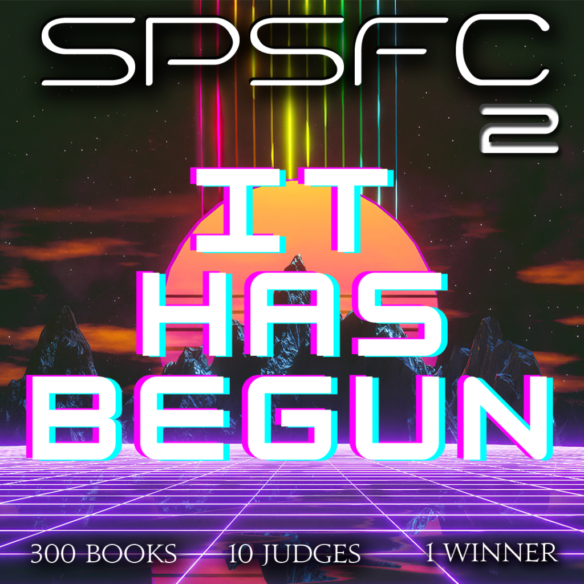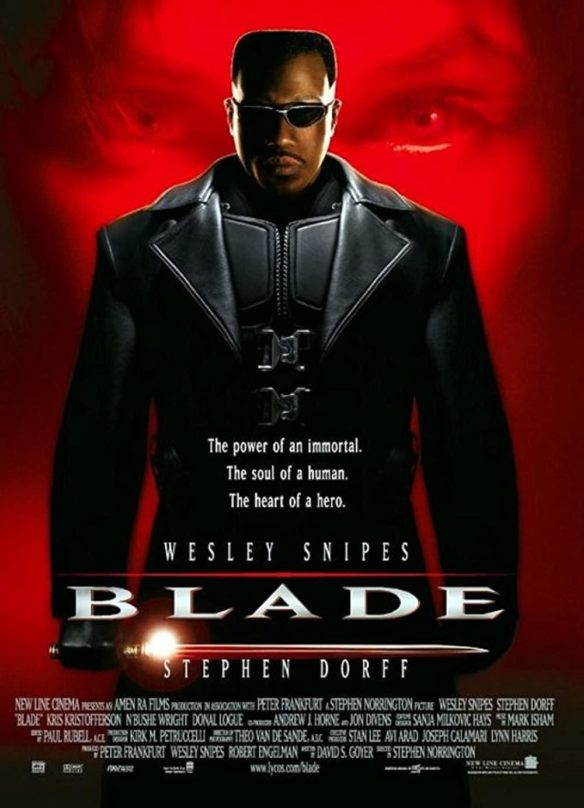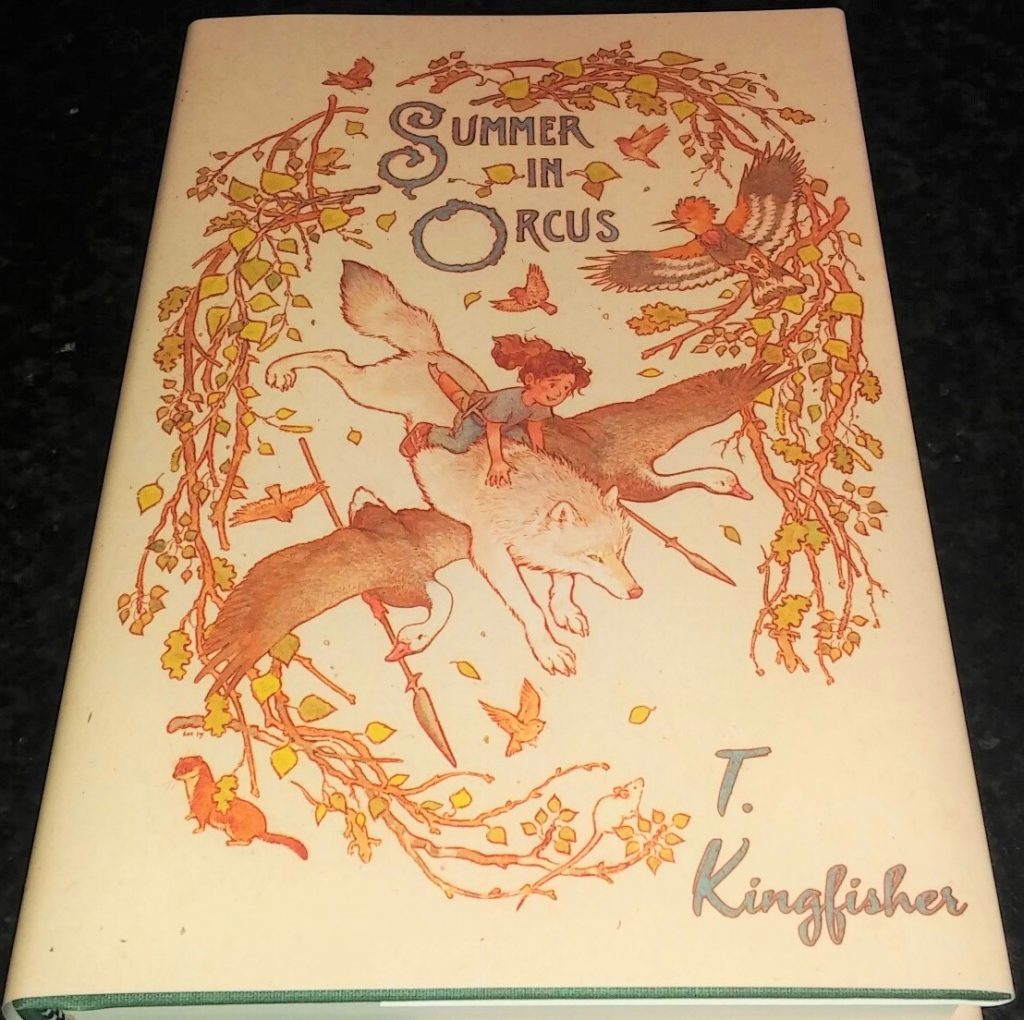(1) F&SF COVER REVEAL. Bob Eggleton created the art on the cover of The Magazine of Fantasy and Science Fiction’s Sept/Oct 2022 issue.

(2) B&N. Barnes & Noble seems to be shifting away from hardcovers and promoting paperbacks, and Middle-Grade / YA authors are particularly worried. At Book Riot, Jenn Northington tries to explain “What Is Going On With Barnes & Noble?”
…Let’s take the newest news first: While much of this is anecdotal, it’s not likely that Barnes & Noble would go on the record about this kind of policy and there are enough supporting responses on Bethany Baptiste’s tweet on August 17th to make it clear that many authors with hardcover releases, particularly in Kids and Middle-Grade, are not being stocked even in their local B&N stores. This isn’t limited to debut authors, either; Kelly Yang, the award-winning author of the Front Desk series, posted a video in which she announced she had been specifically told that B&N would not be stocking the newest book in the series. Scroll through the responses to Baptiste’s tweet, and you’ll see many others with the same story. Independent publisher Disruption Books weighed in to note that this holds true with their own experience.
B&N is a key piece of the in-person bookselling world. Despite Amazon controlling the lion’s share of book sales in the US, everyone in publishing (including indie bookstores) seems united in agreeing that without B&N as even a small counterweight to the e-commerce behemoth, bookselling as we know it would be doomed. As Ellen Adler, publisher of New Press, told the New York Times, “It’s funny how the industry has evolved so that they are now a good guy… I would say their rehabilitation has been total.”…
So let’s add that together for B&N: Central ordering has been down-sized, publishers can no longer pay for placement, stores have less display room, and hardcover sales are down. Add to that the anecdata about B&N buyers being even warier of bringing in newer authors, and you’ve got a recipe for panic.
Which brings us to impact. Discovery is the perennial Holy Grail of publishing: how do you get someone to see or hear about (and then hopefully buy) your new book? There’s no one right answer (and anyone who tells you otherwise is selling something) but physical discovery, i.e. walking into a bookstore and seeing that book on a display table, has long been one of the key elements – which is why publishers have historically been willing to pay for those display spots….
… All of which adds up to, any shift by B&N to carry fewer hardcovers is a blow to discovery, and therefore to authors. If the only hardcovers you can find at your local branch are also the ones that are on the bestseller list, which are also the ones getting marketing dollars, which are also the ones that the algorithms are suggesting to you online, then the chances of, say, a debut author from a marginalized community getting their book in front of your face long enough for you to see it and consider buying it are lower than ever. And let’s be real here: decreases in discovery disproportionately affect authors from marginalized communities.
Laura Anne Gilman posted her response to the B&N news on Facebook.
There is panic once again rumbling through the publishing industry because Barnes & Noble has announced a new hardcover policy that basically fucks over anyone who isn’t already a number one best seller.
This is not good, on very many levels.
However, and I cannot emphasize this enough, this policy appears to apply only to hardcovers, and it’s unclear to my reading if it will apply to all imprints. It’s still not good, but it’s not going to destroy genre publishing. Not until they decide that they’re only gonna take the top book in mass market and or trade, too.
ETA: I would not be entirely surprised if the chains were to do this. They’ve tried it before, it has not worked out well for them.
(Hardcovers have become increasingly expensive, so I’ve been expecting trouble to surface, but I honestly thought it would come from publishers, not booksellers)
And even then, depending on how much autonomy they actually are giving their local stores… well, personally I’m waiting to see how this decision plays out, and how long they keep it in place. If it’s a sales disaster, they will pretend it never happened.
Meanwhile, continue supporting your local and non-local Indies
(3) THEY’RE OFF. The second Self-Published Science Fiction Competition has left the starting line. The SPSFC blog has details: “Let the Games Begin! SPSFC2 is Go!”

Books have been allocated, checked. Covers have been dispersed. The judges are prepped and ready!
WHAT’S NEW THIS YEAR?
This year we’ve made a few adjustments and wanted to highlight them for those following along.
Re-submissions
Firstly, this year we struggled to get to the cap of 300 submissions, so we decided that we would open up the competition to re-submissions for those books who didn’t make it through the slush pile last year. This really helped us hit the cap as we received 112 re-submissions!
With plenty of new judges (currently at 59, with only about 15 returning from last year) we hope to get a fresh set of eyes on these contestants.
… This year we’re going to try our hardest to keep the team progress and communication centralized. We’ll be playing with some ways to keep that going and please tag us on Twitter (@thespsfc) or in the Facebook Group with feedback.
(4) SFF COMMUNITY CALLS FOR VISA TO BE GRANTED TO NIGERIAN AUTHOR. Mimi Mondal is one of many using social media to call for justice in granting a visa so Oghenechovwe Donald Ekpeki can attend Chicon 8. However, they homed in on the U.S. Consul General in Lagos. Consul General Will Stevens, to make this appeal.
Oghenechovwe Donald Ekpeki says, “Apparently that’s the guy in charge. The main man. That could make it all go away with a wave of his hand.”
(5) INTERNATIONAL BARRIERS. Jason Sanford adds some big-picture comments in ”The Barriers Faced By Authors and Creatives Around the World Limit the Future of the SF/F Genre” on Patreon.
Last year I wrote about the financial barriers faced by authors and creatives around the world, barriers that limited their participation in the science fiction and fantasy genre even as the genre grows increasingly global. These barriers are frequently not seen by many people in the United States, Europe, and Australia, even as people in these countries extol the increasing world-wide reach of the SF/F genre.
Sadly, financial barriers aren’t the only walls keeping people in many parts of the world from fully taking part in the SF/F genre. The latest example of such a barrier is Nigerian author Oghenechovwe Donald Ekpeki being denied a visa by the U.S. government to attend the World Science Fiction Convention in Chicago, where he is a Hugo Award finalist in two categories.
(6) EATING THE FANTASTIC. Scott Edelman invites listeners to share brunch on Eggs Benedict with Michael Jan Friedman in Episode 178 of the Eating the Fantastic podcast.

Michael Jan Friedman [has] written more than 70 books — around half of them set in the Star Trek universe. In 1992, he wrote Reunion, the first Star Trek: The Next Generation hardcover, which introduced the crew of the Stargazer, Captain Jean-Luc Picard’s first command. Friedman has also written for the Aliens, Predator, Wolf Man, Lois and Clark, DC Super Hero, Marvel Super Hero, and Wishbone licensed book universes. Eleven of his books, including Hollywood Hulk Hogan and Ghost Hunting (written with Syfy’s Ghost Hunters), have appeared on the New York Times bestseller list. He’s also produced more than 200 comic book stories, including the Darkstars series from DC Comics, which he created with artist Larry Stroman, and the Outlaws limited series, which he created with artist Luke McDonnell. He also co-wrote the story for the second-season Star Trek: Voyager episode “Resistance,” which guest-starred Joel Grey.
We discussed the comic book he refused to trade for Fantastic Four #1 as a kid, how the X-Men might actually be a deconstructed Superman, whether it mattered the Marvel Universe was set in New York rather than DC’s series of fictional cities, why his two favorite superheroes are Green Lantern and Martian Manhunter, the lesson he took from an early encounter with Issac Asimov, how he easily solved a stardate conflict which allowed him to keep Chekov in one of his Star Trek novels, what it was like helping Hulk Hogan write his autobiography, and much more.
(7) TOLKIEN RIGHTS SALE. [Item by David Doering.] Not sure if I should be scared or not. (The Swedes being neutral and all, maybe they are as good a custodian as any.) But it would be like Britain selling the Crown Jewels or Windsor Castle. “Swedish gaming giant buys Lord of the Rings and Hobbit rights” in the Guardian.
The company that owns the rights to JRR Tolkien’s works, including The Lord of the Rings and The Hobbit, has been bought by the Swedish gaming firm Embracer Group, which has hinted it could make spin-off films based on popular characters such as Gandalf, Aragorn and Gollum.
Embracer has acquired Middle-earth Enterprises, the holding company that controls the intellectual property rights to films, video games, board games, merchandise, theme parks and stage productions relating to Tolkien’s two most famous literary franchises.
The deal also includes “matching rights” in other Middle-earth-related literary works authorised by the Tolkien Estate and HarperCollins – primarily The Silmarillion and The Unfinished Tales of Numenor and Middle-earth – which were published after Tolkien’s death in 1973….
(8) IT’S ALL ON THE TABLE. Meanwhile, the Embracer Group shows up in another news report, about the board game market: “The Great Nerdification” at Publishers Weekly.
Once upon a time not so very long ago, any board games beyond the household staples like Monopoly and Scrabble were the exclusive property of, well, nerds. And during this not so very long time ago nerds dwelled on the sidelines, wallflower-like: by near definition they were the opposite of popular.
Today, however, we’re living in what Marc Gascoigne, publisher at Aconyte Books (the fiction imprint of the games publisher and distributor Asmodee Entertainment), calls “the great nerdification.” Thanks to hit TV shows like Stranger Things, which reintroduced the public to the seminal role-playing game Dungeons & Dragons, all types of tabletop games have become more mainstream—and they’re exploding in growth, and raking in big bucks.
According to the research report “Board Games Market by Product, Distribution Channel, and Geography-Forecast and Analysis 2021–2025” by Technavio Research, the market (which spans tabletop, card and dice, and RPGs) will see a year-over-year growth of 7.1% in 2021 alone, and grow at a compound annual growth rate of roughly 13% between 2020 and 2026. Additionally, the research firm Arizton Advisory & Intelligence estimates that tabletop games will rake in more than $4 billion in incremental revenues during this time frame.
This growth spurt in the board game category is partly due to the pandemic, which forced the world indoors and impelled people to find new (or old) ways to entertain themselves and socialize at home.
“The pandemic has only strengthened people’s fun and enjoyment playing board games,” Gascoigne says. “And you can now play many of them online if you can’t play in person.”
Though the board games industry is still small (if not miniature) potatoes in comparison to the video games market, which is forecast to be $300 billion by 2025, according to the Unity Gaming Report 2022, it’s expanding enough to catch the eye of video game companies, such as Swedish gaming developer the Embracer Group….
(9) AND IN THIS CORNER. The Guardian wonders “Who should Predator fight next? Yoda, Children of the Corn, or Sid from Toy Story?”
…It’s perhaps no coincidence that at a time when nobody really wanted another Predator movie, the straight-to-streaming prequel Prey has reinvigorated interest in the long-running saga. Set in North America in 1719, its less-is-more strategy pays off by pitching the alien against a young Native American woman who must use guile and her understanding of the warrior code to fend off an attack from the mandible-sporting alien.
The premise is much more intriguing than the execrable Alien vs Predator movies, and of course the Twittersphere has gone into a predictable loop-the-loop with suggestions for future episodes. Top of the pile is Stephen King’s idea that the extra-terrestrial hunter take on the Children of the Corn, the murderous kids who featured in his 1977 short story (and subsequent torrent of inexplicably bad movies).
Is King joking? Who cares! It’s another sideways option that would keep the Predator franchise searingly alive. Maybe the alien comes down to Earth in search of “He Who Walks Behind the Rows”, the horrible green demon worshipped by the juvenile citizens of Gatlin in King’s novel, and finds he has bitten off more than he can chew. (Can you chew with mandibles?)…
(10) MEDIA BIRTHDAY.
1998 – [By Cat Eldridge.] The first film of the Blade trilogy had its premiere in New York City on this date. Based off the Blade series by writer Marv Wolfman and artist Gene Colan, the screenplay was written by David S. Goyer who would also write Nick Fury: Agent of S.H.I.E.L.D.
Wesley Snipes who plays the very special human-vampire hybrid Blade here would be one of the three producers. And I thought the cast was interesting: Stephen Dorff, Kris Kristofferson, N’Bushe Wright and Donal Logue.
A. Asbjørn Jøn raised the question whether Kris Kristofferson’s Whistler character was based off a character named Whistler in A Dozen Black Roses by Nancy A. Collins which came out two years earlier. Given that filming for this film started at least eighteen months before it got released and that means the screenplay was written at least a year before that, I think not.
To save having to do SPOILERS, I will skip talking about the story which frankly is far less interesting than the sheer physical action here. It’s really watching fun Blade kill vampires in new and frankly gory manners. Snipes is fascinating to watch as he has a dancer’s physical grace as brutally stabs a vampire. Cool. Way cool.
The Blade here is not the Blade of the comics. Goyer replaced the daggers Blade used in the comics with a sword and gave him a more samurai-like aesthetic which explains the dance-like grace I saw in him.
It cost forty million to produce and made a rather excellent one hundred and thirty million.
Critics generally liked it. Roger Ebert of the Chicago Sun-Tribune made a good point when he noted that, “Blade is a movie that relishes high visual style.” And Peter Bradshaw writing for the Guardian said, “Blade is an entertainingly macabre and excitingly staged action horror, with a propulsive energy..”
Audience reviewers at Rotten Tomatoes give a quite stellar seventy eight percent rating.
And yes, I like it rather a lot having seen it at the cinema and then watched it several times on video. I’m not at all fond of the two sequels though.

(11) TODAY’S BIRTHDAYS.
[Compiled by Cat Eldridge.]
- Born August 19, 1921 — Gene Roddenberry. Oh, you know who he is. But did you know he wrote a lot of scripts for Have Gun – Will Travel? Indeed his script for the show, “Helen of Abajinian” would win the Writer’s Guild of America award for Best Teleplay in 1958. And yes, he would share a Hugo for Star Trek’s “The City on the Edge of Forever” episode which was awarded at Baycon. (Died 1991.)
- Born August 19, 1928 — Richard N. Farmer. Author of Islandia Revisited: A Sequel By Other Hands which he claims to be a sequel to Austin Tappan Wright’s Islandia. No, it wasn’t at all authorized. There are authorized sequels to Islandia, three of them, all written by Mark Saxton, the man who edited the original Islandia manuscript. They are, in this order, The Islar, Islandia Today – A Narrative of Lang III, The Two Kingdoms and Havoc in Islandia. Sylvia Wright, Wright’s daughter and the executrix of the estate, died shortly before the third Saxton book was completed. Mark Saxton himself died in 1988, so it’s not really likely that we will see any additional Islandia novels.(Died 1987.)
- Born August 19, 1930 — D.G. Compton, 92. SWFA Author Emeritus whose The Steel Crocodile was nominated for the Nebula Award. The Unsleeping Eye, The Continuous Katherine Mortenhoe in the U.K., was filmed as Death Watch which the Audience Reviewers at Rotten Tomatoes actually like giving it a 60% rating. His two Alec Jordan near-future police stories are superb. He selected for the Cordwainer Smith Rediscovery Award.
- Born August 19, 1938 — Diana Muldaur, 84. She appeared in the original series in two episodes, first in “Return to Tomorrow” as Dr. Ann Mulhall / Thalassa and then in “Is There in Truth No Beauty?” as Dr. Miranda Jones. She, of course, is up again in Next Gen as Dr. Katherine Pulaski. She voiced Dr. Leslie Thompkins in that animated Batman series as well.
- Born August 19, 1940 — Jill St. John, 82. She’s best remembered as Tiffany Case, the Bond girl in Diamonds Are Forever. She was the first American to play a Bond girl. She shows in The Batman in “Smack in the Middle” and “Hi Diddle Riddle” as Molly. And she played Jennifer Holmes in the 1960 film version of The Lost World. Even more fascinatingly she’s one of the uncredited dancers on Rowan & Martin’s Laugh-In!
- Born August 19, 1950 — Mary Doria Russell, 72. The Sparrow series, The Sparrow and its sequel Children of God, are awesome. The Sparrow won the Clarke, BSFA, and Tiptree Awards, and it was the reason she won the Astounding Award for Best New Writer. Though not genre, Doc and its sequel Epitaph are mysteries using the historic character of Doc Holliday.
- Born August 19, 1952 — Jonathan Frakes, 70. Best known for his portrayal of Commander William T. Riker in Next Gen and I’m fond of his voicing David Xanatos on the Gargoyles series which had at least five Trek actors doing voice work. Interesting bit of trivia: For a time in the Seventies, he worked for Marvel Comics at Cons as Captain America. He has directed more than seventy television episodes, including episodes of myriad Trek series, Marvel’s Agents of S.H.I.E.L.D., Leverage, The Librarians and The Orville.
(12) A NICE TURN OF PHRASE. Says Icona:
(13) DEAD RECKONING. Book Riot’s K. W. Colyard spotlights “Murder Mysteries In Space: 10 Thrillers Set Where No One Can Hear You Scream”. First on the list:
THE TEA MASTER AND THE DETECTIVE BY ALIETTE DE BODARD
Aliette de Bodard’s Hugo- and Nebula-nominated novella centers on The Shadow’s Child: a sentient spaceship who has settled into her new life as a wounded veteran. Her latest client is Long Chau: a researcher who needs The Shadow’s Child‘s help acquiring a dead body. But when they realize the body they’ve found is that of a murder victim, this newly acquainted dynamic duo have no choice but to investigate in The Tea Master and the Detective.
(14) IT’S ABOUT TIME. Another SFnal-ish Isaac Arthur here: “Time Wars & Alternate Timelines” on YouTube.
Temporal Paradox and Time Travel delight us in science fiction, but what would a war across time really look like?
(15) VIDEO OF THE DAY. [Item by Martin Morse Wooster.] In “Day Shift Pitch Meeting,” Ryan George explains the new Jamie Foxx vampire hunter movie begins with Jamie Foxx fighting a valued senior citizen, killing her, and stealing her fangs because in this world, the older the vampire, the more valuable their fangs. We learn about the vampires because Foxx and another character “have an exposition battle where they quiz each other on how much they know.” Also, many characters pee their pants and this is a plot point because “vampires don’t pee.”
[Thanks to Andrew Porter, Chris Barkley, Michael Toman, Gordon Van Gelder, Scott Edelman, Jason Sanford, David Doering, SF Concatenation’s Jonathan Cowie, Cat Eldridge, Mike Kennedy, Martin Morse Wooster, JJ, and John King Tarpinian for some of these stories. Title credit belongs to File 770 contributing editor of the day Daniel Dern.]

